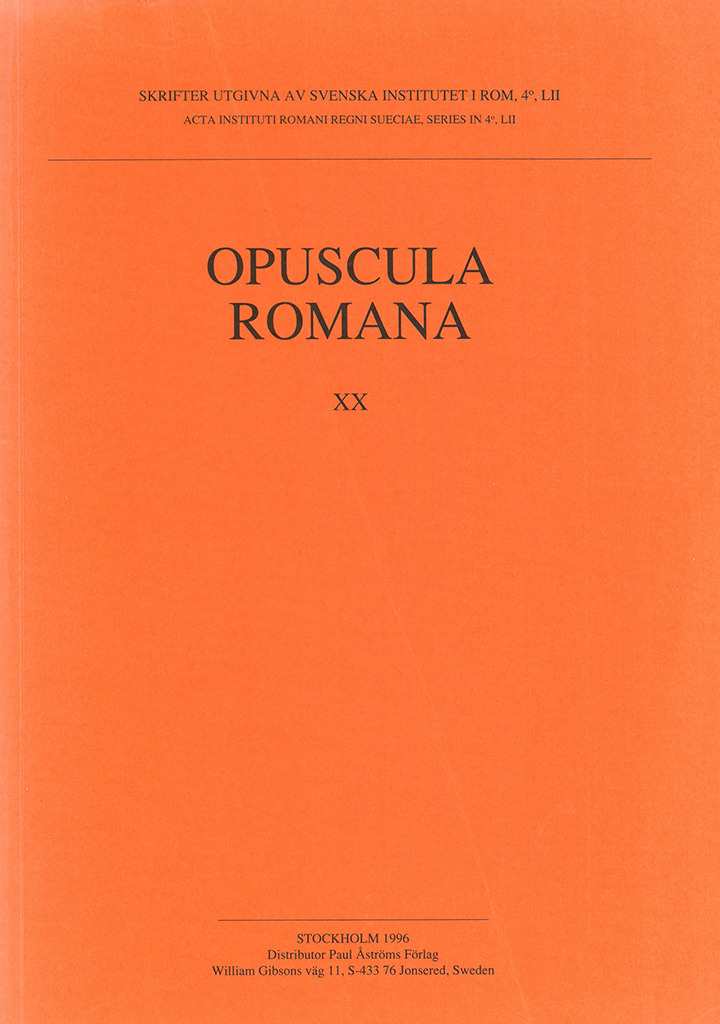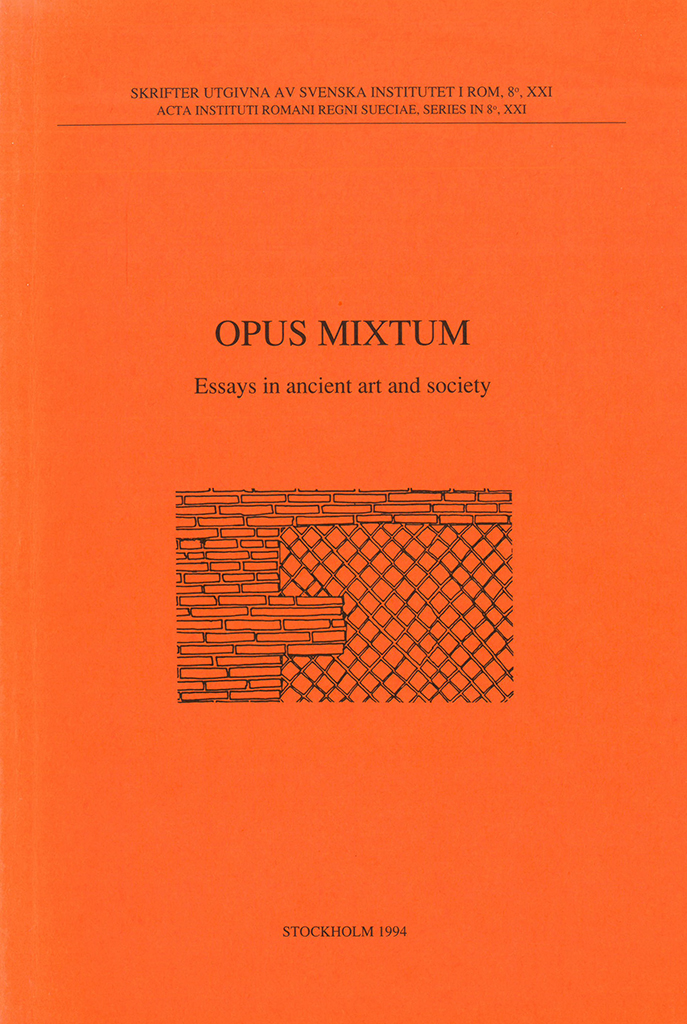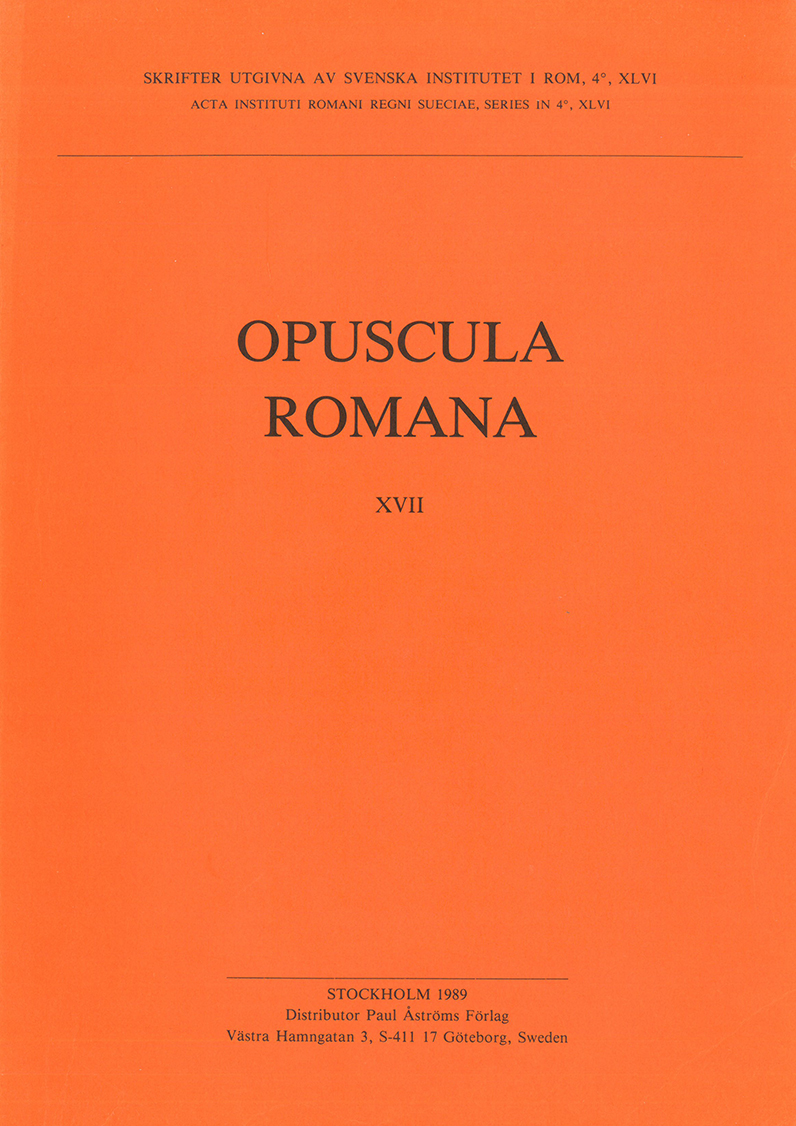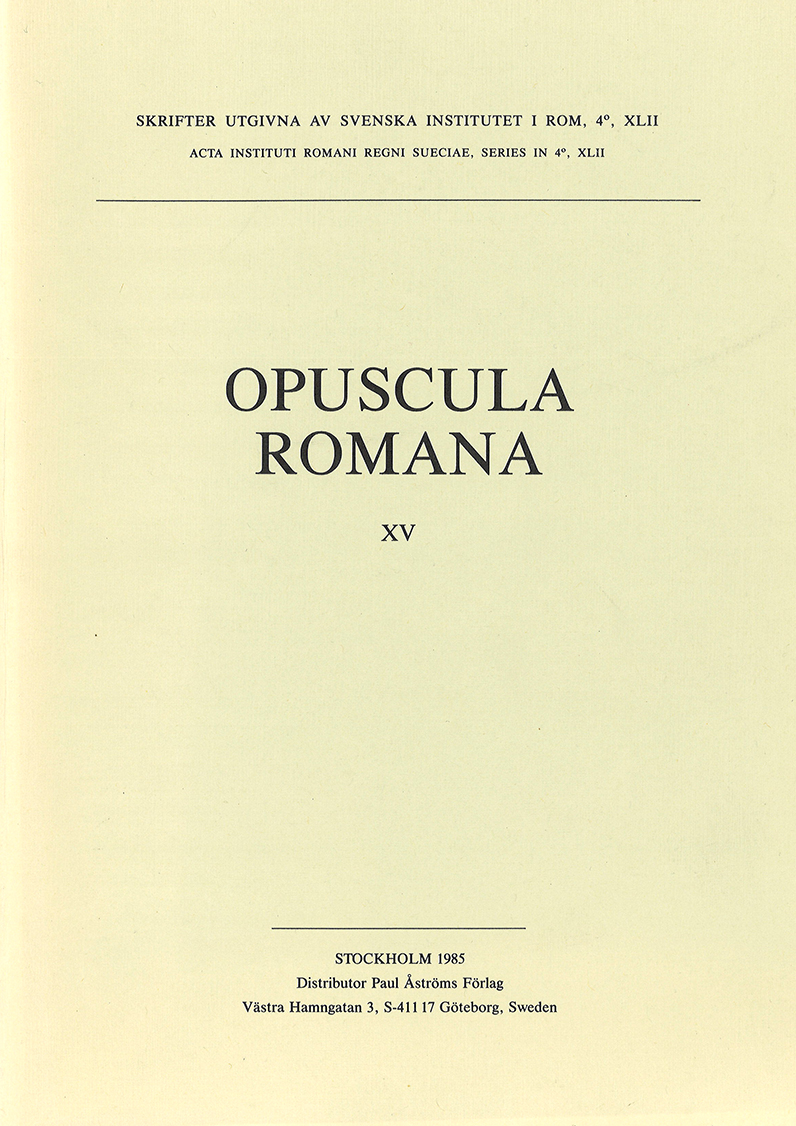Published by the Swedish Institute of Classical Studies in Rome. Distributed by Astrom Editions. Pär Göran Gierow dedicata Opuscula Romana 20 Contents Kristina Berggren, Tre tombe a cremazione con trace di legno nella necropolis di Quattro Fontanili a Veio (Roma) Ingrid E.M. Edlund-Berry, The power of cults and sacred spaces. The interpretation romana of sanctuaries in southern Italy and Sicily Maria C. Eriksson, Two Etruscan mirrors in the Thorwaldsen Museum, Copenhagen Björn Forsén & Timo Sironen, Bolli laterizi romani nell’Antikmuseet in Göteborg Lena Landgren, The Roman pleasure garden—foundations for future studies Peter Liljenstolpe, De ornamentis templi Urbis. Reconstructing the main order of the temple of Venus and Roma in Rome Alessandro Naso, Osservazioni sull’origine dei tumuli monumentali nell’Italia centrale David Ridgway, Greek letters at Osteria dell’Osa Paavo Roos, Strabo and the water-mill at Cabeira. Some considerations Raffaele Santillo, Il «saxum ingentem» a Ravenna a copertura del Mausoleo di Teoderico: problemi e soluzioni Martin Söderlind, A central Italic, terracotta votive head in the Classical Museum of Antiquities in Lund (in association with Pierluigi Bianchetti, technical analysis) Margareta Strandberg Olofsson, Pottery from the monumental area at Acquarossa: a preliminary report Bengt E. Thomasson, Laterculi praesidium. Addendorum series altera Örjan Wikander, Senators and equites….
Published by the Swedish Institute of Classical Studies in Rome. Distributed by Astrom Editions. Opus Mixtum. Essays in ancient art and society Edited by Eva Rystedt, Charlotte Scheffer and Charlotte Wikander Abstract Fifteen papers on various aspects of ancient art and society are gathered in this volume. They deal with the choice of moment depicted in the Parthenon frieze, the use of the Greek architectural orders in political propaganda, and the “programme” of the relief plaques from zone F at Acquarossa which is suggested to be celebrations connected to the ruler. The architectural layout of a well-temple in Sardinia is interpreted as an iconographic message of the cult of Tanit-Astarte. The significance of the horse in connection with death and the various types of female deities connected with horses in Archaic Greek religion are discussed, as well as the image of Artemis Ephesia and its connection with the mysteries of the goddess, the epithet Ambologera (“Delayer of old age”) attributed to Aphrodite, and the role of women in Roman religion. A white-ground lekythos by the Achilles Painter with the “mistress-and-maid” motif associated with music-making is analysed. A reconstruction of the Laocoon group, especially regarding the positions of the serpents is…
Published by the Swedish Institute of Classical Studies in Rome. Distributed by Astrom Editions. Deliciae fictiles. Proceedings of the First International Conference on Central Italic Architectural Terracottas at the Swedish Institute in Rome, 10–12 December 1990 Edited by Eva Rystedt, Charlotte Wikander & Örjan Wikander Abstract Thirty-three papers on architectural terracottas read at an international conference in Rome. The papers include contributions on Greek material, but the main emphasis is placed on Central Italic roofs (from Northern Etruria to Campania) from the Archaic period. Several papers present hitherto unpublished material, either recently excavated or from earlier, unpublished, excavations and collections. Contents Eva Rystedt, ‘Preface’, p. 7 Arvid Andrén, ‘L’avviamento’, p. 9 ‘General list of abbreviations’, pp. 11–16 Nancy A. Winter, ‘The Greek background for Archaic architectural terracottas of Central Italy’, pp. 17–20 John F. Kenfield, ‘A modelled terracotta frieze from Archaic Morgantina: its East Greek and Central Italian affinities’, pp. 21–28 Concetta Ciurcina, ‘Rapporti tra le terrecotte architettoniche della Sicilia orientale e quelle dell’Italia centrale’, pp. 29–38 Elena Epifanio Vanni, ‘Antefisse di tipo campano a Himera’, pp. 39–43 Maria Bonghi Jovino, ‘La decorazione architettonica di Capua: peculiarità, itinerarii e modelli’, pp. 45–54 Ninina Cuomo di Caprio & Matilde Romito, ‘Fratti…
Published by the Swedish Institute of Classical Studies in Rome. Distributed by Astrom Editions. Opuscula Romana 17 Contents Johnny Bengtsson, ‘Survey in Italy, “La Farnesina project”’, pp. 7–8 Mats Cullhed, ‘Maxentius as princeps‘, pp. 9–19 Ingrid Edlund-Berry, ‘Four terracotta heads from Poggio Civitate (Murlo). Towards a definition of the ‘Murlo style’’, pp. 21–32 Gloria Ferrari, ‘Felicior Augusto—portrait medallions in glass and the Ravenna relief’, pp. 33–60 Erik Holmberg, ‘Who made the vases of the Red-Line Painter and relations?’, pp. 61–76 Lars Karlsson, ‘Some notes on the fortifications of Greek Sicily’, pp. 77–89 Giordano Labud, ‘Il territorio del sito archeologico di San Simone d’Isola’, pp. 91–95 Kyle M. Phillips, Jr. (†), ‘Notes from Berlin on a bronze owl’, pp. 97–122 Stefania Quilici Gigli, ‘Paesaggi storici dell’agro falisco: i prata di Corchiano’, pp. 123–134 Pontus Reimers, ‘“Opus omnium dictum maximum”. Literary sources for the knowledge of Roman city drainage’, pp. 137–141 Barbro Santillo Frizell, ‘The autonomous development of dry masonry domes in the Mediterranean area. Some considerations’, pp. 143–161 Margareta Strandberg Olofsson, ‘On the reconstruction of the monumental area at Acquarossa’, pp. 163–183 Örjan Wikander, ‘Asonius’ saw-mills—once more’, pp. 185–190 Örjan Wikander, ‘Roman and Medieval tile-roofs. Evidence from representations’, pp. 191–203 Örjan…
Published by the Swedish Institute of Classical Studies in Rome. Distributed by Astrom Editions. Opuscula Romana 16 Contents Giovanni Colonna, ‘Il maestro dell’Ercole e delle Minerva. Nuova luce sull’attività dell’officina veiente’, pp. 7–41. Ingrid E.M. Edlund, ‘The sacred geography of southern Italy in Lycophron’s Alexandra’, pp. 43–49. Harry Erkell, ‘Varroniana III. Studi topografici. – Il culto all’Ara Maxima. Varro, De lingua latina V §§ 51–54 e VI § 54’, pp. 51–57. Erik J. Holmberg, ‘The Red-Line Painter’, pp. 59–90. Erik Nielsen, ‘Some preliminary thoughts on new and old terracottas’, pp. 91–119. Gad Rausing, ‘Charcoal, wheat and history’, pp. 121–124. Jocelyn Penny Small, ‘Left, right, and center: direction in Etruscan art’, pp. 125–135. Örjan Wikander, ‘Senators and equites. II. The aristocracy as agents of production’, pp. 137–145. Charlotte Wikander, Örjan Wikander & Giovanni Colonna, ‘An Etruscan inscription from Acquarossa’, pp. 147–148. Sebastian P.Q. Rahtz, ‘The Protestant Cemetery, Rome. A study undertaken under the auspices of the Unione Internazionale degli Instituti di Archeologia, Stora e Stora dell’arte in Roma. Interim report’, pp. 149–167. Carl Nylander, ‘The Swedish Institute in Rome (founded 1926). Report for the academic years 1984/85 and 1985/86’, pp. 169–171. ‘Guide for contributors to Opuscula Atheniensia and Opuscula Romana’, pp….
Published by the Swedish Institute of Classical Studies in Rome. Out of print. The gods and the place. Location and function of sanctuaries in the countryside of Etruria and Magna Graecia (700–400 B.C.) By Ingrid Edlund Bibliographical information Ingrid Edlund, The gods and the place. Location and function of sanctuaries in the countryside of Etruria and Magna Graecia (700–400 B.C.) (Skrifter utgivna av Svenska institutet i Rom, 4°, 43), Stockholm 1987. Softcover: 108 pp. ISSN 0081-993X. ISBN 9789170421198.
Published by the Swedish Institute of Classical Studies in Rome. Distributed by Astrom Editions. Opuscula Romana 15 Contents Patrikk Bruun, ‘From polis to metropolis. Notes on Thessalonica in the administration of the Late Roman Empire´, pp. 7–16. Lucos Cozza, ‘La grande pianta di Falerii esposta nel museo di Villa Giulia’, pp. 17–46. Ingrid Edlund, ‘A terracotta head from Poggio Civitate (Murlo)’, pp. 47–53. Harry Erkell, ‘Varroniana II. Studi topografici in Varro, De lingua Latina V, §§45–50’, pp. 55–65. Hack Kampmann, ‘The ustrinum in Palazzo del Parlamento in Rome’, pp. 67–78. John Kraft, ‘The Cretan Labyrinth and the walls of Troy. An analysis of Roman labyrinth designs’, pp. 79–86. Anne-Marie Leander Touati, ‘A marble head in the Swedish Institute in Rome’, pp. 87–92. Hugo Montgomery, ‘Decurion and clergy—some suggestions’, pp. 93–95. Eva Rystedt, ‘An unusual Etruscan vase from Chiusi’, pp. 97–104. Charlotte Scheffer, ‘Was there a garden at Poggio Civitate?’, pp. 105–108. Bengt E. Thomasson, ‘Zur Laufbahn einiger Statthalter des Prinzipats’, pp. 109–141. David Whitehouse, ‘Medieval pottery from Luni sul Mignone’, pp. 143–147. Örjan Wikander, ‘Mill channels, weirs and ponds. The environment of ancient watermills’, pp. 149–154. Örjan Wikander, ‘Senators and equites. I. The case of the Aufidii’, pp. 155–63. Guide…






